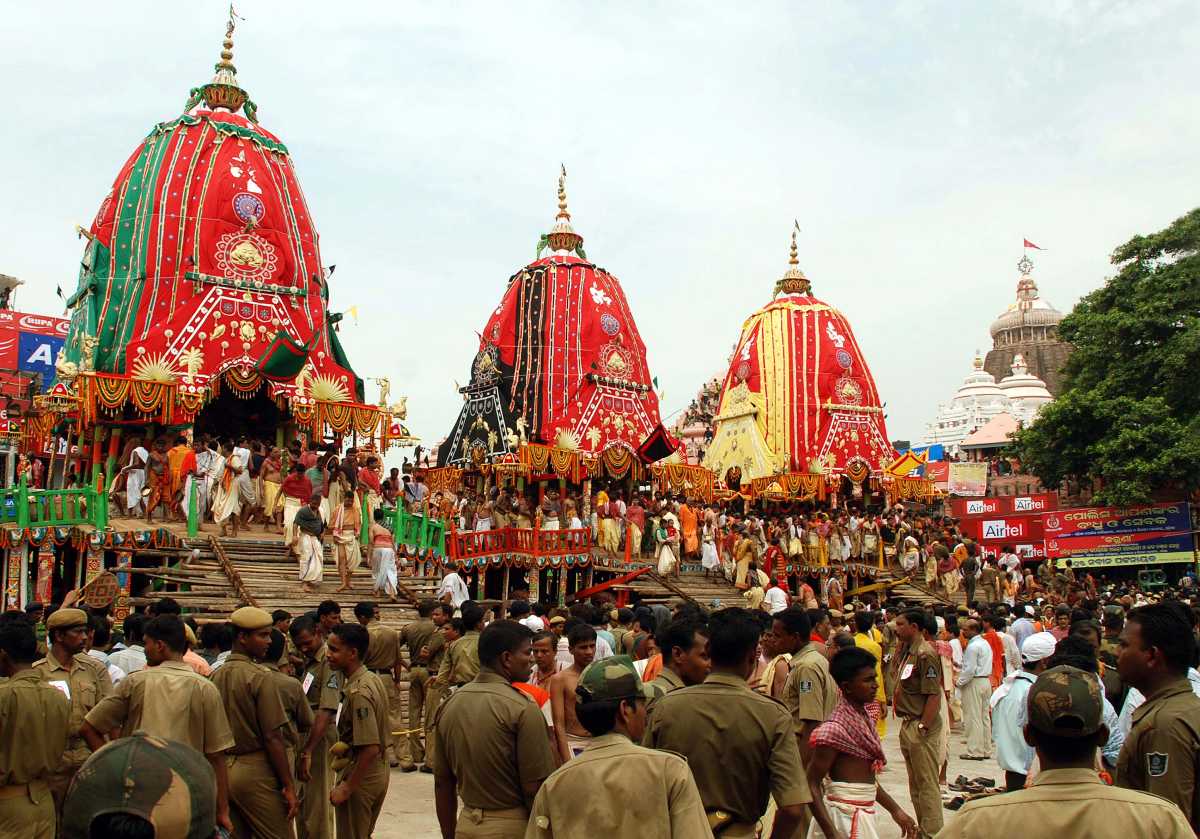
History of Rath Yatra
Jagannath's Rath Yatra is one of the most historically and religiously significant festivities that are held in the country. This festival has also been mentioned in the Puranas of Hinduism including Padma, Brahma, and Skanda Purana. Rath Yatra is organized every year due to the belief that every year Lord Krishna visits his birth place Mathura for a few days. In order to fulfil the wishes of the Lord, every year this yatra is conducted with its starting point being Jagannath Temple. The ostentatious procession's last destination is the Gundicha Temple, where the wishes of Kanha are fulfilled. It is one of the grandest and oldest festivals celebrated in India every year. The next Jagannath Rath Yatra is scheduled for the14 of July
2018.
Puja Rituals
Every year, the three deities are carried on chariots few miles away to Gundicha Temple on the second day of the new moon in the month of Ashada (June-July) according to the Hindu calendar. It is probably the only time when an idol is taken out of the temple in India. Prior to the Puri Rath Yatra, the three idols are given a ritualistic bath after which they are kept in isolation till the procession day as they become slightly discoloured after the bath and are considered ill for that duration of time. On the day of the Yatra, people gather around the temple chanting and dancing while waiting for the King of Puri who is a descendant of the Royal Family of Orissa, to bring the idols out of the temple. He is the only person who has complete authority over the Jagannath Temple. He sweeps the chariot with a gold handle broom and decorates the floor of the chariot with flowers before deeming it fit for the deities. He then sweeps the ground in front of the chariots and sprinkles sandalwood water around. This is a famous ritual of the Yatra called as the Chhera Pahara. This ritual signifies that everyone is equal in the eyes of the Lord. Placing the idols in the Chariots itself takes a couple of hours but the enthusiasm of the devotees only rises.
The Yatra
The distance from Puri to Gundicha temple is roughly 3 km however due to a large crowd, Puri Rath Yatra takes a couple hours to reach. Once reached, the deities reside at the temple for a period of nine days where pilgrims are allowed darshan before taking it back to Puri in the same way. The return journey is called the Bahuda Yatra. On the way back, the procession halts at the Mausi Maa Temple (their aunt's abode) where the deities are served with Poda Pitha (a kind of a sweet pancake). It is a said to be a poor man's food which was a favourite of Lord Jagannath. Apart from the religious affair, this Puri Rath Yatra greatly signifies the feeling of brotherhood that is present among the people who gather here in spite of coming from different social structures and parts of the world.
Types of Raths
Undoubtedly, the chariots or 'Raths' are the focal point of the procession in Puri. There are three main chariots carrying three deities that are a part of the celebration. All the three chariots are made of wood and decorated by local artists. Lord Jagannath's chariot is the biggest of the three having 16 massive wheels and a height of 44 feet. While Lord Balabhadra's chariot has 14 wheels and a height of 43 feet followed by Goddess Subhadra's chariot having 12 wheels and a height of 42 feet.
The first one of them is theNandighosa Rath, which is the holy seat of Lord Jagannath himself who is accompanied by Lord Madan Mohan. The wagon is guarded by Garuda while the charioteer is Daruka. This Ratha stands out with its yellow and red decorative clothing as these are the favourite colours of the Lord. This Ratha is also called Garuda dhwaja Ratha or Kapila Ratha. Other deities in this chariot include Varaha, Gobardhan, Krishna, Gopi Krishna, Nursingha, Rama, Narayan, Trivikrama, Hanuman and Rudra.
The second Ratha is theTaladhwaja Rathand the presiding deity of this chariot is Lord Bala Bhadra. The accompanying deity is Lord Rama Krishna, and this wagon is embellished with red and blue-green clothes. Basudev stands guarding this chariot, while the charioteer is Matali. Other deities in this Ratha include Ganesh, Sheshadeva, Mukteswar, Natamvara, Mrutyunjaya, Hatayudha, Pralambar, Sarvamangala and Kartikeya.
Smallest of the three chariots is theDarpadalana Rathawhich belongs to Lord Jagannath's sister Goddess Subhadra. Adorned with red and black colour clothes, this chariot is guarded Jayadurga and the charioteer is Arjuna. This Ratha also carries Vimala, Mangala, Shyamakali, Varahi, Shulidurga, Vanadurga, Ugratara, Chamunda and Chandi.
In Puri Rath Yatra, Lord Balaram's chariot is pulled first, then Goddess Subhadra's followed by Lord Jagannath's.
How to Reach Jagannath Rath Yatra
A network of local buses from Gundicha Temple is the most convenient way to make a visit to the Rath Yatra.
Top Tourist Places in Puri
Puri Beach
Jagannath Rath Yatra
Chilika Lake
Narendra Tank
Lokanath Temple
Markandeswara Temple
All Tourist Places in Puri
Where to Stay
A few hotels located near the main venue of the Rath Yatra include The Hans Coco Palms, Shree Vishnu Darshan Holiday Home, Mayfair Waves and Hotel Sands Bay.
Tips
1. Since the Yatra is attended by huge masses of people every year, it is advisable for one to keep a track of their belongings and keep some food packets as well as water bottles handy.
2. The crowds here can get overwhelming, so keep safe and be careful of how you navigate here.
Photos of Jagannath Rath Yatra
Comments on Jagannath Rath Yatra
Post Your Comment



















